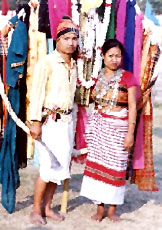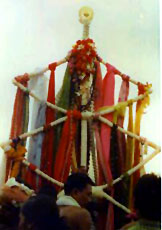 The term "Jamatia" means those who do not fear the burden of tax. Jamatia Tribes are one of the numerically important tribes of Tripura. Jamatia tribes are a well organised group who are confined in a small and compact territory. Most of them live in Udaipur and Amarpur sub-divisions of South Tripura District. These Jamatia tribes have got distinctive Mongoloid features, which enable every one to identify them. Physically Jamatia tribes are firm, sturdy, brave and powerful. The Jamatia tribes have been inducted in to the regal force due to this reason. It was apparently demonstrated by the powerful rebel leader called Porikshit Jamatia who struggled against the unfair oppressiveness by the corrupt officials of the kings.
The term "Jamatia" means those who do not fear the burden of tax. Jamatia Tribes are one of the numerically important tribes of Tripura. Jamatia tribes are a well organised group who are confined in a small and compact territory. Most of them live in Udaipur and Amarpur sub-divisions of South Tripura District. These Jamatia tribes have got distinctive Mongoloid features, which enable every one to identify them. Physically Jamatia tribes are firm, sturdy, brave and powerful. The Jamatia tribes have been inducted in to the regal force due to this reason. It was apparently demonstrated by the powerful rebel leader called Porikshit Jamatia who struggled against the unfair oppressiveness by the corrupt officials of the kings.
Jamatia tribal community can be divided in to sub- tribal groups. These include Puratias(Debbarma), and the Reang . Hoda is the third largest sub tribal group. Jamatia is an endogamous group which has no exogamous division unlike clans. All Jamatia tribes belong to Kashyap golra which was conferred upon them by the king Birchandra Manikya in the year 1863. This was done so that they don`t face any difficulty in getting the services of the Brahmin in their religious observances and rituals. They speak kokbard language which belongs to the Bodo branch of the Tibeto-Burmese linguistic group. Jamatia tribes also speak Bengali language fluently. The Jamatia belong to the Mongoloid stock. They claim descent from the lunar race.
Society of Jamatia Tribes
Marriage among the Jamatia tribes has both a religious and social aspects. Jamatia tribes have different forms of marriage. Kaglaimani and Hanjuk Kailamani are the forms of marriage in Jamatia society. Marriage takes place within the endogamous groups. No man or woman can marry within the same lineage as all the members of the clan are supposed to have descended from the same person. Hypogamy is followed in the Jamatia society. Monogamy is common form of marriage but polygamy is also permitted.
Mud huts are constructed on a high land. The village has only one approach-road. Other sides are covered with jungle, high hills all of which give natural enrichment to the village. Previously they lived in bamboo made piled huts known as Tong. Shifting cultivation is practiced by few Jamatia families though most of them have become agriculturist. Paddy and maize are grown and millet is also sown broadcast in the same field. Mixed cultivation meets their major needs, food from paddy and maize, drink from millet and vegetables from brinjal, mustard and chilli. Some of them are engaged in subsidiary occupations like live stock raising, fishing, kitchen gardening and handicraft.
 Remarriage is practiced among the divorced and widowed persons. In the Jamatia society woman is considered as asset.
Remarriage is practiced among the divorced and widowed persons. In the Jamatia society woman is considered as asset.
Religion of Jamatia Tribes
In case of the religion also, these Jamatia tribes arduously follow the tradition of other tribal communities of the state. Almost all the sub tribal groups of the Jamatia community revere Goria mwtai with lots of veneration. Also these Jamatia tribes worship other deities including `the Mahadev or Mwtai Kotor, Tripura sundori, twima`, and also other deity of `fourteen gods`.
Closely related to religious practices of these Jamatia tribes, there is a myth popular amongst the Jamatia tribal community. According to it The Jamatia tribes were irritated and disturbed after the armed insurrection under the leadership of Porkshit Jamatia was being curved down. The Jamatia tribes determined to get out of the state `en-mass` and transmigrate to adjacent territory. The king Beer Chandra appeased the angry Jamatia tribal community by grading them as higher class in comparison with the other tribal communities of the Tripura state. From that time onwards, these Jamatia tribes have been converted to the religion of Vaishnavism. These Jamatia tribes also have developed the feeling that they were superior and thus did not permit any people from other tribal community to enter into their kitchen.
Political life of Jamatia Tribes
The well defined customs, panel system and a hierarchy of social officers to whom the whole tribe renders obedience, constitutes three tier administrative structures-
(i) Luko Panchayat (Village council)
(ii) Moyal Panchayat (Regional council)
(iii) Hada (Supreme council).
Recent Changes in the Jamatia society
Due to constant contact with the neighbouring Bengali immigrants some Hindu customs have been absorbed by them. The Jamatia have been following their customary laws and traditional customs due to their well organised political councils. Changes have been observed in their material culture and economy but social customs have remain unchanged.
















